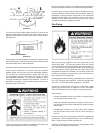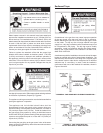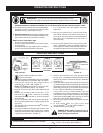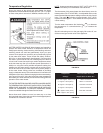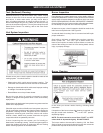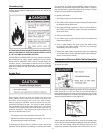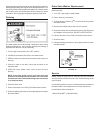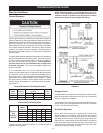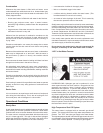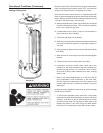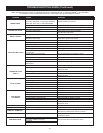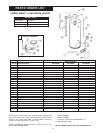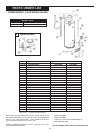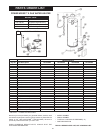
24
Condensation
Whenever the water heater is lled with cold water, some
condensate will form while the burner is on. A water heater may
appear to be leaking when in fact the water is condensation. This
usually happens when:
• A new water heater is lled with cold water for the rst time.
• Burning gas produces water vapor In water heaters,
particularly high efciency models where ue temperatures
are lower.
• Large amounts of hot water are used in a short time and the
rell water in the tank is very cold.
Moisture from the products of combustion condense on the
cooler tank surfaces and form drops of water which may fall
onto the burner or other hot surfaces to produce a “sizzling” or
“frying” noise.
Excessive condensation can cause pilot outage due to water
running down the ue tube onto the main burner and putting
out the pilot.
Because of the suddenness and amount of water, condensation
water may be diagnosed as a “tank leak”. After the water in
the tank warms up (about 1-2 hours), the condition should
disappear.
Do not assume the water heater is leaking until there has been
enough time for the water in the tank to warm up.
An undersized water heater will cause more condensation.
The water heater must be sized properly to meet the family’s
demands for hot water including dishwashers, washing machines
and shower heads.
Excessive condensation may be noticed during the winter and
early spring months when incoming water temperatures are at
their lowest.
Good venting is essential for a gas red water heater to operate
properly as well as to carry away products of combustion and
water vapor.
Smoke Odor
It is not uncommon to experience a small amount of smoke and
odor during the initial start-up. This is due to burning off of oil
from metal parts, and will disappear in a short while.
Operational Conditions
Smelly Odor
In each water heater there is installed at least one anode rod (see
parts section) for corrosion protection of the tank. Certain water
conditions will cause a reaction between this rod and the water.
The most common complaint associated with the anode rod is
one of a “rotten egg smell”. This odor is derived from hydrogen
sulde gas dissolved in the water. The smell is the result of four
factors which must all be present for the odor to develop:
• a concentration of sulfate in the supply water.
• little or no dissolved oxygen in the water.
• a sulfate reducing bacteria within the water heater. (This
harmless bacteria is non-toxic to humans.)
• an excess of active hydrogen in the tank. This is caused by
the corrosion protective action of the anode.
Smelly water may be eliminated or reduced in some water heater
models by replacing the anode(s) with one of less active material,
and then chlorinating the water heater tank and all hot water
lines. Contact Sears Service for further information concerning
an Anode Replacement Kit #9001453 and this Chlorination
Treatment. Anode replacement and chlorination of the tank are
not covered by the water heater’s limited warranty.
If the smelly water persists after the anode replacement and
chlorination treatment, it may be necessary to chlorinate or aerate
your water supply to eliminate the problem.
Do not remove the anode leaving the tank unprotected. By
doing so, all warranty on the water heater tank is voided.
“AIR” In Hot Water Faucets
HYDROGEN GAS: Hydrogen gas can be produced in a hot
water system that has not been used for a long period of time
(generally two weeks or more). Hydrogen gas is extremely
ammable and explosive. To prevent the possibility of injury
under these conditions, we recommend the hot water faucet,
located farthest away, be opened for several minutes before
any electrical appliances which are connected to the hot water
system are used (such as a dishwasher or washing machine).
If hydrogen gas is present, there will probably be an unusual
sound similar to air escaping through the pipe as the hot water
faucet is opened. There must be no smoking or open ame near
the faucet at the time it is open.
High Temperature Shut Off System
This water heater is equipped with an automatic gas shutoff
system. This system works when high water temperatures are
present. Turn “OFF” the entire gas supply to the water heater.
The high temperature shutoff is built into the gas control valve. It is
non-resettable. If the high temperature shutoff activates, the gas
control valve must be replaced. Contact your gas supplier.



